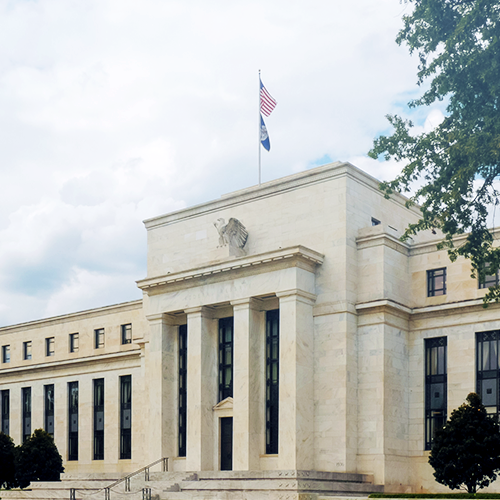
August 2025
How Stablecoins Will Change the Way the U.S. Does Business
Plus, Aristotle Pacific CEO Dominic Nolan talks about opportunities in fixed income, Fed expectations, and market action.
Download PDFWe recently sat down with Dominic Nolan, CEO of Aristotle Pacific Capital, to get his insights into the groundbreaking GENIUS Act recently passed by Congress and what it may mean to businesses and the economy, the Fed’s next moves, recent market action, and opportunities in fixed income. We finished with a random round of questions and personal reflection.
Market Performance: Total Return

Let’s start with markets. U.S. stocks and below investment-grade bonds had a solid month. What happened?
Overall, it’s been an excellent year so far for equities with the Dow Jones Industrial Average at an all-time high. On the fixed-income side, bonds were generally flat in July, except for below investment grade and bank loans. For the year, those two asset classes are up about 5% (high yield) and 3.71% (bank loans), driven mostly by the coupon. Interest rates have had some volatility, but pretty much range bound. I think what happened in July is markets have gotten more comfortable as the trade deals have started to come through the pipeline and the Big Beautiful Bill Act passed. This has brought more clarity to investors. However, there are still significant questions about the economy that remain unanswered. In particular, the short and long-term impact of tariffs.
Mag 7

How About the Mag 7?
July was a good month for six of the Mag 7 with Tesla continuing to struggle. It was down almost -3% for the month and a stunning -23.67% for the year. We’re into earnings season right now, and we’ve seen some great beats from Alphabet, Meta and Microsoft. This AI boom has been substantial. Nvidia—up over 32% for the year—is supplying the picks and shovels. Microsoft, with its ownership stake in Open AI, is up 27% this year. And Meta, which has been very aggressive in the AI space, is up over 32%. Also of note is Microsoft in July became the second company to cross the $4 trillion market cap, right behind Nvidia.
U.S. Treasury Yield Curve: Intermediate Maturities Have Borne the Brunt of Volatility in 2025

U.S. Treasury yields rose across the curve with the largest moves at the two- and three-year maturities. What drove rates higher?
I would use two words: “clarity” about the trade deals and the Big Beautiful Bill Act and “resiliency,” which I think applies to the economy, the consumer and inflation. On a cautionary note, markets are continuing to process what will happen with tariffs, inflation, deregulation, immigration, and other government initiatives—it’s a lot. Despite all this, the curve continues to be range bound, however the belly the curve is bearing the brunt of volatility. Once should also take note on the long bond, whose yield has moved by a decent amount.
Fed Futures: Two Cuts Expected in 2025

July’s FOMC meeting concluded with no interest-rate cut, but we did have two dissenting votes. Do you expect more differences of opinion in the months ahead?
If the Fed doesn’t cut in September, there will be more dissenters. But after a weak jobs report earlier this month, the odds now stand at 95% there will be a September cut. The market is still anticipating two to two-and-a-half cuts this year, which means a third cut is now on the table. I think it’s hard to argue the recent political pushing for cuts isn’t influencing the dissenters. I could make the case for the Fed to cut, but on the other hand, the stock market is at an all-time high, and the job market—while slowing— has shown resiliency.
Economic Dashboard

On that note, what’s the current economic data telling us?
Right now, the shaky jobs picture is getting the most attention, as it should given the recent numbers that show hiring has sharply slowed. In July, the U.S. added about 73,000 non-farm jobs when forecasts were for 110,000. In addition, early reports from May and June were revised downward by 250,000 jobs. Even so, unemployment—which stands at 4.2%—has remained relatively low. However, the recent jobs reports have given the Fed room to cut, and that’s why you’re seeing September probabilities of a Fed rate cut spike substantially.
Now for our special topic: Stablecoins have been more and more in the news lately and appear to be having a significant impact on the way business is done globally. Let’s start with the basics: What are stablecoins?
At a high level, I think the easiest way to describe stablecoins is that they are digital cash typically backed by a U.S. dollar, which makes the price stable relative to other cryptocurrencies such as bitcoin.
How Stablecoins Will Change the Way the U.S. Does Business

Why are stablecoins suddenly in the conversation?
Congress in bipartisan fashion passed a groundbreaking bill called the GENIUS (Guiding and Establishing National Innovation for U.S. Stablecoins) Act, which provides regulatory guidelines for stablecoins. I think it was a smart move by our government to do this and akin to pegging oil to the U.S. dollar back in the 1970s, which had positive long-term effects. This bill essentially provides regulation to integrate stablecoins into our financial system. As you can see in the chart below, the dollar value of stablecoin transactions has grown to the point of rivaling major payment processors.
How Stablecoins Will Change the Way the U.S. Does Business

Can you provide more details about Tether, the leader in the stablecoins?
Tether is a stablecoin that’s backed mostly by U.S. dollars and makes up approximately 70% of the stablecoin market, which is currently around $250 billion. Just two years ago, the market was half of that. Two reasons Tether is so dominant: 1) it started back in 2014, so it had significant advantage as a first mover; and 2) it has focused on non-U.S. markets, which have propelled the popularity of stablecoins. Why has the U.S. been a laggard? Domestically, we have one of the strongest banking systems in the world. So, for us, the benefits of stablecoins are not as compelling because we trust our banks. When you make a deposit, you know you’ll get your money back. That is not the case in many other countries, which are finding instant access to U.S. dollars in digital form very appealing.
How Stablecoins Will Change the Way the U.S. Does Business

Is this translating into profits?
Tether made a net profit last year of $13 billion, more than twice that of BlackRock (the largest asset manager in the world), more than Citi, and a little less than Morgan Stanley and Goldman Sachs. And Tether did this with less than 250 employees. In contrast, Morgan Stanley has a workforce of 80,000. The primary driver of these profits has been interest on USD backing. Stablecoins do not pay interest, but Tether gets to invest the underlying collateral into U.S. Treasuries, which pay about 4%.
Stablecoins Offer Transformatiave Capabilities

How Stablecoins Will Change the Way the U.S. Does Business

Do you think stablecoins are a bank or a payment-processor killer?
This really gets to the value add. If you owe somebody less than $1,000, how do you get that money to him or her? Some, mostly older people still use checks, which can take up to a week or so to clear. I use Venmo. Others prefer Zelle. But what if you want to transfer a sizable amount of money that’s beyond the limits of Venmo or Zelle? Now you’re getting into bank-wire territory along with the accompanying fees. It’s inefficient and expensive, especially considering our high-tech world. Stablecoins allow you to transfer funds instantaneously with substantially cheaper fees. Think about how attractive this could be to small business owners. Credit-card fees are about 3%, and if you’re a low-margin business, that cuts significantly into your profits. With stablecoins, that fee could drop to 10 cents—or 30 times less than credit-card fees. From the standpoint of our current financial infrastructure, stablecoins are substantially more efficient but not yet widely adopted—in part because regulation hasn’t been there, which is why I think the long-term effects of the GENIUS Act are going to be substantial.
What are the long-term implications of this and who do you think the winners and losers will be?
In 2024, stablecoins have bought over $40 billion in Treasury bills, which is on par with China and money-market funds. It turns out, these relatively unknown companies are monstrous buyers of U.S. Treasury bills, and that is only going to increase with the GENIUS Act, which will provide more trust and transparency for this kind of digital currency. At a fundamental level, I believe the clear winner is the U.S. dollar and Treasuries, which back stablecoins one-for-one. As for the losers, it is difficult to tell since we’re in the opening innings, but payment processing companies have an emerging contender. The real long-term effects are very difficult to estimate, though I think it’s a fair conclusion that it could be substantial.
Fixed Income Yields and Year-to-Date Returns

Where do you see opportunities in fixed income today?
I think the slowness in the economy is short-term in nature, in part because of tariff anxiety. Couple this uncertainty with the recent weak jobs report, providing the Fed some wiggle room to cut. This leads me To preferring fixed rate Risk over floating rate risk. Given the economy seems to be in a healthy enough spot, investment grade corporates are my preference within fixed rate. The argument for floating rate relies on the economy recovering in 2025, which I think is a fair base case and some inflation pressures resulting from immigration driven tightness in the labor market.
Okay, I’ll give you a word or phrase, and you tell me what comes to mind: The remodel of the Federal Reserve buildings in Washington D.C.
This was approved in 2019 for $1.9 billion, but the costs have gone up to $2.5 billion, an overrun the Fed blames on increased costs caused by pandemic related inflation and tariffs. Keep in mind, the remodel was approved during Trump’s first administration, and now it’s being used as collateral against Chair Jerome Powell. But $2.5 billion, including an overrun of over a half-billion dollars, is staggering. It tells you either how antiquated the Fed buildings are or how egregious government spending is.
Speaking of Powell, what are the chances he serves out his term?
His term ends in May of next year. Though he’s taking a lot of flack from President Trump right now, I would think he’s going to finish his term. It would be surprising if he didn’t, and it would be unfortunate because the Fed needs to keep its independence.
The latest round of tariffs.
We’re striking deals, and it seems as though the administration is not backing off. It’s really about a handful of major trading partners. I found the Japan negotiations interesting. The headlines highlighted Japan’s promised $500 billion investment in the U.S. Most of that, by the way, will be loans into the U.S. Essentially, we have a trade deficit of about $70 billion with Japan. Automobiles are critical to their economy. So, if the U.S. put 30-plus percent tariff on Japan as originally proposed, that would not have worked for them. Now the 30-plus percent tariff has been basically cut in half, and that’s palatable to Japanese automakers. But in exchange, because Japan’s economy still isn’t going to open up as much they struck the finance deal with the U.S. I would equate it to buying down your home interest rate— Japan agreed to help finance $500 billion in U.S. projects in exchange for bringing down the tariff rate. Both sides got creative to close the deal.
Let’s close with a personal reflection.
Bill Gates is credited with saying the following regarding technology, “We always overestimate the change that will occur in the next two years and underestimate the change that will occur in the next ten.” Let’s take stablecoins, I recently listened to an interview with Jeremy Allaire, CEO of the digital currency company Circle. He said when it comes to stablecoins, we’re still in the equivalent of the pre-iPhone cellphone era. Before the iPhone came along in 2007, mobile phones had been around for some time, but they hadn’t really captured the consumers’ imagination. The year before the iPhone, the number-one selling cellphone was the Nokia 1600. If you look up that phone, it appears from today’s vantage point to be made in the dark ages. When the iPhone finally arrived, it changed everything. I feel we are now in that same pre-iPhone phase with so many technologies, including digital currency. It’s difficult to imagine what comes next, but I look forward to watching it all unfold.
A 10-year Treasury note is a debt obligation issued by the United States government with a 10-year maturity period.
Bank loans (or floating-rate loans) are financial instruments that pay a variable or floating interest rate. A floating rate fund invests in bonds and debt instruments whose
A bond is a fixed-income instrument and investment product where individuals lend money to a government or company at a certain interest rate for an amount of time. The entity repays individuals with interest in addition to the original face value of the bond.
Coupon refers to the interest payment that a bond issuer promises to pay to a bondholder.
Fixed income refers to assets and securities that pay a set level of income to investors, typically in the form of fixed interest or dividends.
FOMC refers to the Federal Reserve’s Federal Open Market Committee.
Investment grade refers to the quality of a company's credit. To be considered an investment grade issue, the company must be rated at 'BBB' or higher by Standard and Poor's or Moody's.
An investment-grade bond is a type of bond that is considered to have a relatively low risk of default.
Market Cap is the current market value of all of a company's outstanding stock shares. It is often used to indicate a company's size and worth in comparison to its peers.
Stablecoins are a type of cryptocurrency designed to maintain a stable value by pegging to fiat currencies, commodities, or financial instruments."
A Treasury bill is a debt security issued by the U.S. Treasury that matures in fewer than 52 weeks.
Treasury rate (or yield) refers to the interest rate at which the U.S. government borrows money by issuing Treasury securities.
Volatility is a statistical measure of the dispersion of returns for a given security or market index. In most cases, the higher the volatility, the riskier the security.
Yield is the income returned on an investment, such as the interest received from holding a security.
A yield curve plots the interest rates of bonds that have equal credit quality but different maturity dates.
Any performance data quoted represent past performance, which does not guarantee future results. Index performance is not indicative of any fund’s performance. Indexes are unmanaged and it is not possible to invest directly in an index. For current standardized performance of the funds, please visit www.AristotleFunds.com.
The views expressed are as of the publication date and are presented for informational purposes only. These views should not be considered as investment advice, an endorsement of any security, mutual fund, sector or index, or to predict performance of any investment or market. Any forward-looking statements are not guaranteed. All material is compiled from sources believed to be reliable, but accuracy cannot be guaranteed. The opinions expressed herein are subject to change without notice as market and other conditions warrant.
Investors should consider a fund’s investment goal, risk, charges and expenses carefully before investing. The prospectus contains this and other information about the fund and can be obtained at www.AristotleFunds.com. It should be read carefully before investing.
Investing involves risk. Principal loss is possible.
A full list of holdings can be found at www.aristotlefunds.com and are subject to risk and to change at anytime. Any discussion of individual companies is not intended as a recommendation to buy, hold or sell securities issued by those companies.
Aristotle Funds and Foreside Financial Services, LLC are not affiliated with Pacific Life Fund Advisors LLC.
Foreside Financial Services, LLC, distributor.



